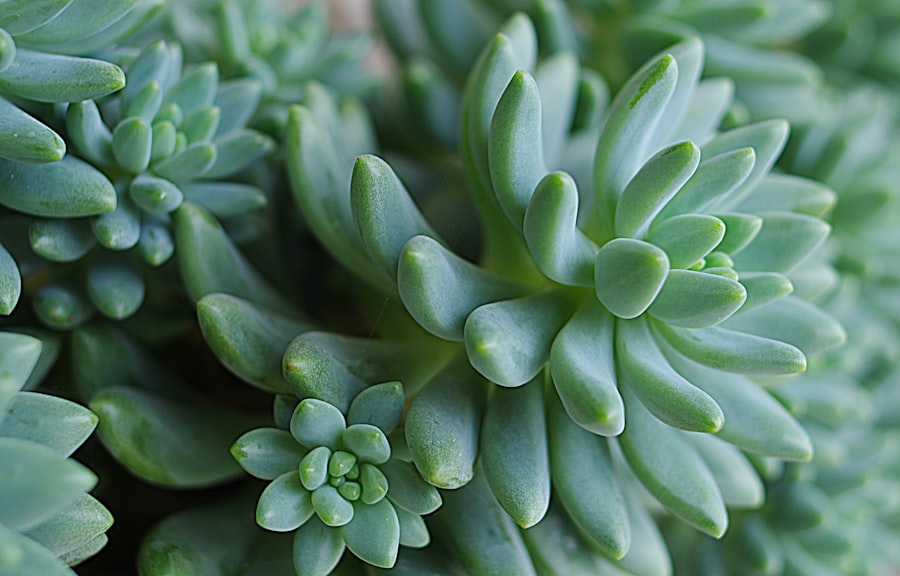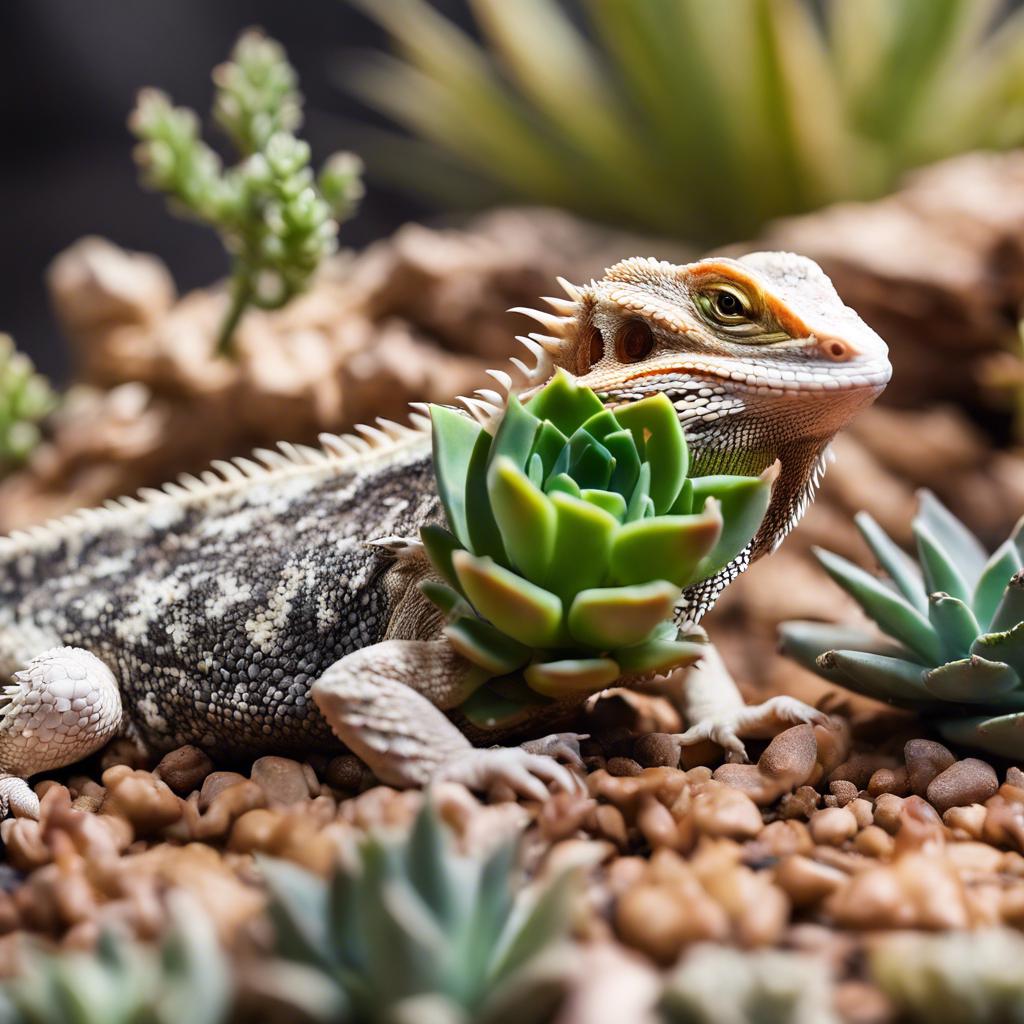Succulents have become increasingly popular as houseplants due to their unique and beautiful appearance. These plants are known for their ability to store water in their leaves, making them low-maintenance and perfect for those who may not have a green thumb. But did you know that succulents can also be a great addition to your bearded dragon's habitat?
Bearded dragons are fascinating reptiles that require a well-balanced diet and a suitable environment to thrive. Adding safe succulents to their habitat can provide numerous benefits, including visual stimulation, humidity regulation, and even potential nutritional value. However, it is crucial to choose the right succulents for your bearded dragon to ensure their safety and well-being.
Key Takeaways
- Choosing safe succulents is important for the health and well-being of your bearded dragon.
- Factors to consider when choosing safe succulents include toxicity, texture, and size.
- Top safe succulents for bearded dragons include hens and chicks, sedum, and echeveria.
- Introduce succulents slowly and monitor your bearded dragon's interaction with them.
- Proper care for succulents includes providing the right environment, watering and feeding, and identifying and treating health issues.
Importance of Choosing Safe Succulents for Your Bearded Dragon
Choosing safe succulents for your bearded dragon is of utmost importance to prevent any potential harm or toxicity. While many succulents are harmless, some can be toxic to reptiles like bearded dragons. Ingesting toxic plants can lead to various health issues, including digestive problems, organ damage, and even death.
It is essential to research and identify the succulents that are safe for your bearded dragon before introducing them into their habitat. This will help you create a safe and enriching environment for your pet while minimizing any potential risks.
Factors to Consider When Choosing Safe Succulents for Your Bearded Dragon
When selecting safe succulents for your bearded dragon, there are several factors to consider. First and foremost, you need to ensure that the succulent is non-toxic and safe for reptiles. Some common succulents that are safe for bearded dragons include Aloe vera, Sedum burrito (Burro's Tail), and Echeveria species.
Additionally, it is crucial to consider the size and growth habit of the succulent. Bearded dragons are curious creatures and may try to climb or interact with the plants in their habitat. Choosing succulents that are not too tall or have sharp spines can help prevent any injuries to your pet.
Lastly, it is essential to research the succulent's toxicity level. While some succulents may be safe for bearded dragons, they may still cause mild irritation if ingested in large quantities. Understanding the potential risks associated with each succulent will help you make an informed decision and ensure the safety of your pet.
Top Safe Succulents for Bearded Dragons
1. Aloe vera: Aloe vera is a popular succulent known for its medicinal properties. It is safe for bearded dragons and can even provide some nutritional benefits. Aloe vera can help soothe skin irritations and aid in digestion when consumed in small amounts.
2. Sedum burrito (Burro's Tail): This trailing succulent is safe for bearded dragons and adds a unique aesthetic to their habitat. It requires bright indirect light and infrequent watering, making it low-maintenance.
3. Echeveria species: Echeveria species, such as Echeveria elegans (Mexican Snowball) and Echeveria pulvinata (Plush Plant), are safe for bearded dragons. These rosette-shaped succulents come in various colors and require well-draining soil and bright light.
How to Properly Introduce Succulents to Your Bearded Dragon's Habitat
When introducing succulents to your bearded dragon's habitat, it is essential to do so gradually. Sudden changes in their environment can cause stress and potentially harm your pet. Start by placing the succulent in a separate container within the habitat, allowing your bearded dragon to become familiar with its presence.
After a few days, you can slowly introduce the succulent into the habitat, ensuring that it is securely planted and cannot be easily uprooted. Monitor your bearded dragon's behavior and make any necessary adjustments to ensure their safety and comfort.
Bearded Dragon Care: Providing the Right Environment for Succulents

To ensure the health and well-being of your succulents, it is crucial to provide the right environment within your bearded dragon's habitat. Succulents thrive in bright light, so placing them near a window or providing artificial lighting is essential. Bearded dragons also require UVB lighting for their own health, so ensure that the succulents receive adequate exposure to this type of light as well.
Temperature is another important factor to consider. Most succulents prefer temperatures between 60-80°F (15-27°C). This temperature range coincides with the ideal temperature range for bearded dragons, making it easier to create a suitable environment for both your pet and the succulents.
Bearded Dragon Care: Watering and Feeding Succulents
Succulents have unique watering requirements due to their ability to store water in their leaves. Overwatering can lead to root rot and other issues, so it is crucial to water them sparingly. Allow the soil to dry out completely between waterings and ensure that excess water drains out of the pot.
Feeding succulents is not necessary as they obtain nutrients from the soil they are planted in. However, if you choose to fertilize your succulents, it is important to use a fertilizer specifically formulated for succulents and follow the instructions carefully. Avoid using fertilizers that contain high levels of nitrogen, as this can be harmful to both the succulents and your bearded dragon.
Bearded Dragon Care: Monitoring Your Bearded Dragon's Interaction with Succulents
While most safe succulents pose no harm to bearded dragons, it is still important to monitor their interaction with the plants. Bearded dragons may be curious and attempt to nibble on the leaves or climb on the succulents. Ingesting large quantities of any plant material can lead to digestive issues, so it is crucial to prevent your pet from consuming excessive amounts of succulents.
If you notice any signs of distress or abnormal behavior in your bearded dragon after introducing succulents, it is best to remove the plants from their habitat and consult a veterinarian.
Bearded Dragon Care: Identifying and Treating Succulent-Related Health Issues
Despite your best efforts, there may be instances where your bearded dragon experiences health issues related to succulents. It is important to be able to identify these issues and seek appropriate treatment.
Some common symptoms of succulent-related health issues in bearded dragons include diarrhea, vomiting, loss of appetite, and lethargy. If you notice any of these symptoms, it is best to consult a reptile veterinarian who can provide a proper diagnosis and treatment plan.
Treatment may involve removing the succulents from the habitat, providing supportive care such as fluid therapy, and addressing any underlying health issues that may have been exacerbated by the ingestion of the plants.
Enjoying Safe Succulents with Your Bearded Dragon
In conclusion, incorporating safe succulents into your bearded dragon's habitat can provide numerous benefits while adding visual interest to their environment. However, it is crucial to choose the right succulents and ensure their safety by researching their toxicity levels and monitoring your pet's interaction with them.
By providing the right environment, proper watering and feeding, and monitoring your bearded dragon's health, you can enjoy the beauty of succulents while keeping your pet safe and healthy. Remember to consult a reptile veterinarian if you have any concerns or notice any signs of distress in your bearded dragon.
If you're a bearded dragon owner, you know how important it is to provide them with a safe and nutritious diet. One question that often comes up is whether certain plants are safe for them to eat. If you're wondering about the safety of succulents for your bearded dragon, you'll want to check out this informative article on Reptile Wizard's website. It provides valuable insights into whether succulents are a suitable food option for your scaly friend. To read the article, click here: https://reptilewizard.com/reptile-keeping/are-succulents-safe-for-bearded-dragons/.
FAQs
What are succulents?
Succulents are plants that store water in their leaves, stems, and roots. They are known for their thick, fleshy appearance and come in a variety of shapes and sizes.
Can bearded dragons eat succulents?
Yes, bearded dragons can eat certain types of succulents. However, it is important to choose safe varieties that are non-toxic and easy to digest.
What are some safe succulents for bearded dragons?
Some safe succulents for bearded dragons include hens and chicks, sedum, echeveria, and jade plants. These plants are non-toxic and have a low risk of causing digestive issues.
What types of succulents should be avoided?
Bearded dragons should avoid succulents that are toxic or difficult to digest. Some examples include aloe vera, agave, and cactus plants. These plants can cause digestive issues and even be fatal in some cases.
How should succulents be prepared for bearded dragons?
Succulents should be thoroughly washed and chopped into small pieces before feeding to bearded dragons. It is also important to remove any thorns or spines that may be present.
Can bearded dragons eat succulent flowers?
Bearded dragons can eat some types of succulent flowers, but it is important to research each specific variety before feeding. Some flowers may be toxic or difficult to digest.
How often should bearded dragons be fed succulents?
Succulents should be fed to bearded dragons in moderation, as they are not a primary food source. It is recommended to offer succulents as a treat once or twice a week.

